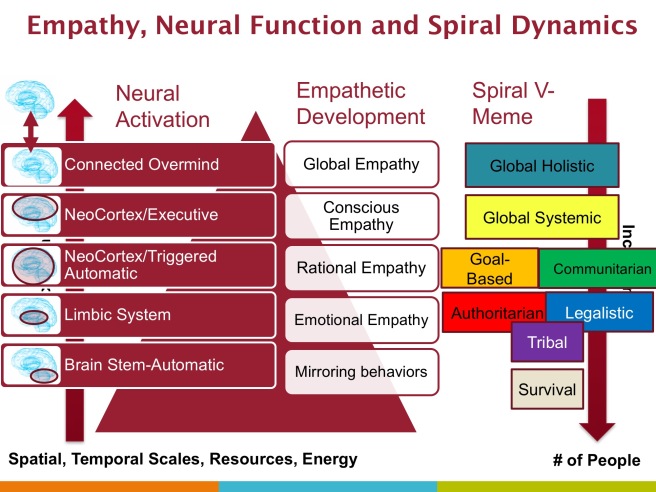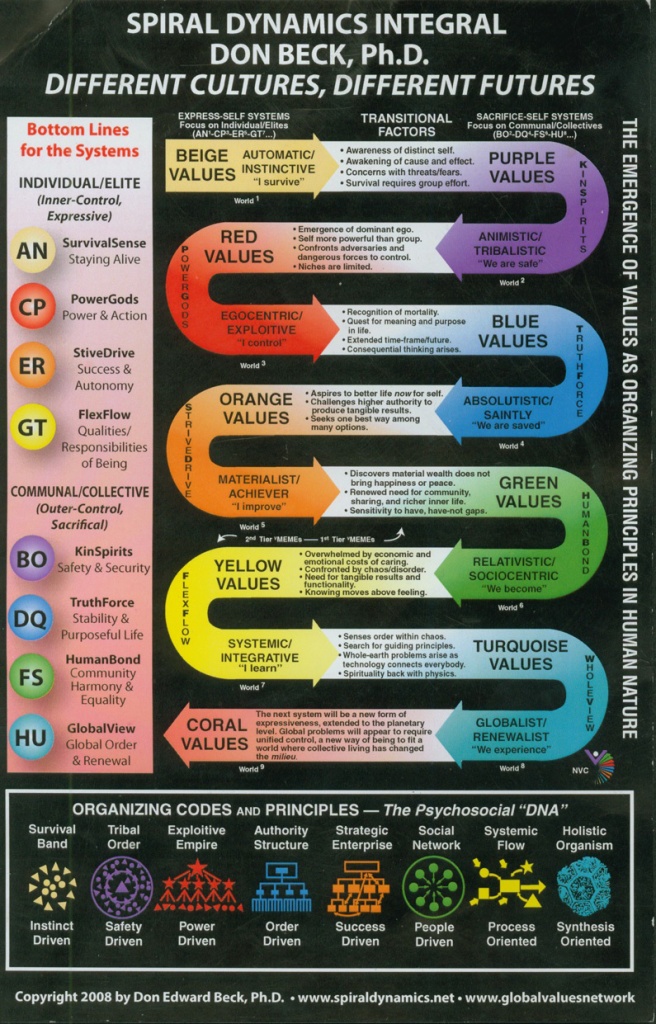Great Horned Owl, in the backyard
The main point of this blog is the following thesis:
Social Structures <=> Knowledge Structures <=> Designs/ Environments/Messaging/Everything that Humans Create (DEMEHC)
If you want more complex and sophisticated DEMEHC, you have to have more sophisticated social structures that creates the knowledge structures, that then lead to the DEMEHC! Where this comes from is called Conway’s Law — a statement by a famous programmer, Melvin Conway, almost 50 years ago. He said ‘The design of a product will look like the communication structure of the organization that produced it.’ This blog spends lots of time elaborating on this seemingly simple principle.
What makes more synergistic social structures is EMPATHY. Empathy, however, is not just a single, monolithic thing. It is an EMERGENT phenomenon that takes different forms and becomes more complex as we evolve. The model of empathy used in this blog is pictured below:
The other concept that can be very difficult that this blog explains in depth is that PEOPLE THINK DIFFERENTLY. What trips people up is that this blog makes the point that people don’t just think differently about surface-level things. They actually structure their thinking differently. Their brains are wired differently. How their brains are wired is largely dependent on their culture, as well as their personal development. And this feeds back into society in what is called a SELF SIMILAR fashion. Societies (and their empathetic levels) create different levels of empathy in their members, spread probabilistically, and members, in turn, create societies that embody their own empathetic levels.
A HUGE implication of this is that we are not the same people we were 1000 years ago. And the people 1000 years ago were not the same as people 10000 years ago. While there is no difference genetically between humans, there are ENORMOUS differences in how people’s software in their brains exists — both in the past, and currently.
This is best represented with a theory called Spiral Dynamics — invented by Clare Graves, Don Beck, and Chris Cowan, along with Spiral Dynamics Integral, invented by Ken Wilber. They quantify the levels of empathetic sophistication in people’s heads with what are called VALUE-MEMES, or v-Memes. V-Memes are the governing meta-rules present in any given social structure. For example, if you’re in an Authoritarian structure, the most important thing is to do what the boss says. If you’re in a Communitarian structure, the most important thing is to treat each other in an egalitarian fashion. If you’re in a Performance/Goal-Based structure, you should be goal-focused in yours, and your society’s activities. And so on. Spiral Dynamics works like a Russian nested (Matryoshka) doll — once you (or your society) evolves to a given level, you have the v-Memes at that level, as well as all the ones below it on the Spiral.
The big breakthrough in Spiral Dynamics is that societies and people evolve, or devolve over time — and the greater the evolution, the more v-Memes they have at their disposal to solve their problems. Don Beck’s ad flyer, that lays out the Spiral, is below. Note that he matches the Spiral levels to social structures.
The major insight of this blog is to hook Empathy to Neurobiology and Human Developmental Stages to Societal Developmental Stages to Knowledge Sophistication and Synergy to Design Sophistication. How all of this unpacks is what this blog is about. Here’s another figure that helps clarify this cross-connection:

Super-cross-similarity chart. As we move toward the top of this chart, the spatial, temporal scales, resources and energy necessary to evolve people at these modes statistically goes up (i.e. you want someone to be Global Holistic, it’s going to take a lot more experiences, learning, etc. than just creating a survival mindset, from a statistical perspective. As the arrow on the right also shows, the # of people possessing these more evolved traits goes down.
To sum up — this blog hooks together these Big Three Ideas –> Conway’s Law, Empathetic Development, and Spiral Dynamics –> with everything that humans, both individually and in aggregate — say and do. And then finally relates that back to our own, fundamental neuroscience — what goes on in our heads.
It’s a tall order! It is the story of evolving sentience — what Isaac Asimov called Psychohistory. Fun!


this psychonaut gets it…You are using the integrated system of SD and applying it to design, with also the hope of elevating empathetic sophistication (thus reducing pain, insanity, and poorly made crap).
LikeLiked by 1 person
Are we in charge of our sentient development, or an experiment in the mind of some higher consciousness? Gotta wonder sometimes!
LikeLike
If we take psychopaths as the base-line (e.g. Dabrowski), with no empathy and with intelligence subordinated to primitive drives, then I suggest the levels of empathy might go a bit like this:
Conscious global empathy
Subconscious global empathy (the first stirrings of empathy for out-groups and other species)
Conscious empathy (we become aware of our own empathy for our own group and species)
Subconscious empathy (the first stirrings of empathy for our own group and own species)
Subconscious mirroring (in non-psychopaths e.g. individuals with normal underlying instincts)
Cognitive / cold / rational empathy (psychopaths work out to a certain degree what targets are experiencing though without truly understanding / feeling it)
Rational / conscious mirroring (a trick psychopaths use to hide)
*
*
‘You walk up to the accident site, look briefly at the child, and then focus on the grief-stricken mother. After a few minutes of careful scrutiny, you walk back to your apartment, go into the bathroom, stand in front of the mirror, and practice mimicking the facial expressions and body language of the mother.’
‘Snakes in Suits’, Babiak and Hare
*
*
‘Many of the characteristics displayed by psychopaths – especially their egocentricity, lack of remorse, shallow emotions, and deceitfulness – are closely associated with a profound lack of empathy (an inability to construct a mental and emotional “facsimile” of another person). They seem unable to “get into the skin” or to “walk in the shoes” of others, except in a purely intellectual sense. The feeling of other people are of no concern to psychopaths.’
‘Without Conscience’, Hare
*
*
‘Recently, a pair of new terms, ”cold” and ”hot” empathy has been introduced in the field of prosocial behavior (Davis & Kraus, 1991; McIllwain, 2003). Cold empathy is fundamentally based on cognitive processes: with its use we are able to understand how the other person feels, and to comprehend what losses, deficiencies and disappointments might have caused their present situation; but we do not share their emotional states. This kind of connection is considered as a form of perspective taking, placing ourselves in their situation, without adopting the emotions stemming from it (Davis & Stone, 2003).
‘Hot” empathy, on the other hand means that we are able to experience the emotional state of the observed others, and thus feel the urge to come to their assistance.’
‘Adult theory of mind, cooperation, Machiavellianism: The effect of mindreading on social relations’, Tünde Paál, Tamás Bereczkei
*
*
‘Despite attenuated fear and empathy (Hare 2003), people with psychopathic traits seem able to successfully manipulate and charm others (Cleckley 1941; Hare 2003), implying that they are able to use socially relevant information to manipulate the people around them. Supporting this idea, people with psychopathic traits do appear to have insight into the intentions, emotions, and motivations of other people (Richell et al. 2003). Interpreting others’ actions and intentions involves knowledge of mental states. Our everyday understanding of others, or “folk psychology” (Stitch and Ravenscroft 1994) is a fundamental resource for introducing meaning to the world around us. This interpretive ability can be viewed as an ability to understand others and ourselves in terms of mental states and has also been called “theory of mind” (Premack and Woodruff 1978), namely, the ability to interpret others’ minds in terms of intentional states such as beliefs and desires (Leslie and German 1995). Clearly, Theory of Mind would be valuable in manipulating and deceiving others in a variety of contexts.’
‘Social, Sexual, and Violent Predation: Are Psychopathic Traits Evolutionarily Adaptive?’, J. Reid Meloy
*
*
Indeed, one of the most exquisite of all human social behaviors involves the ability to attribute mental states to other people, often referred to as a theory of mind (Adolphs, 2003), and it appears that this ability is generally intact in psychopathic individuals (Dolan & Fullam, 2004; Richell et al., 2003).
‘THE SUPER-ORDINATE NATURE OF THE PSYCHOPATHY CHECKLIST-REVISED’, Newmann, Hare, Neuman
LikeLike
Not a fan of this system — it’s empirical and not network-based. I write pretty extensively on psychopathy as a relational disorder. The advantage is that it’s highly reliable, whereas individual traits vary pretty widely among the population. See the Readers Guide for a whole section on this subject.
LikeLike